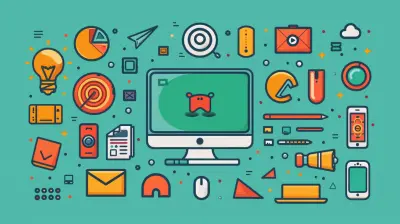How to Balance Group Projects and Individual Work Efficiently
23 August 2025
Balancing group projects and individual work can feel like juggling a dozen balls at once. It’s one of those skills that no one really teaches you outright, but it’s essential for academic success and even more so in the workplace. Whether you're in school or navigating a career, knowing how to effectively manage both collaborative and solo tasks is key to keeping your sanity intact.
In this article, we're going to dive deep into strategies that can help you strike that perfect balance. From time management tips to communication hacks, you'll walk away with a toolkit to manage group projects and personal tasks like a pro.
Let’s get started!
Why Balancing Group and Individual Work Can Be Tricky
Think about it for a second: when you're working on a project solo, you have full control over your schedule, your priorities, and your pace. You’re the boss of yourself. But when you add a group project into the mix, things get a little more complicated. Suddenly, you’re dealing with different personalities, working styles, and availability.It’s like trying to sync up a playlist when everyone has their own taste in music. Some people want rock, others want classical, and you’re just trying to avoid a complete cacophony. Balancing these two work modes—group and individual—requires a lot of finesse.
But the good news is, with the right approach, you can master this balancing act. Here’s how.
1. Prioritize Your Tasks Early On
Before you even begin working on a group project or individual task, it's essential to know what’s ahead. One of the most common mistakes people make is not prioritizing their tasks from the start. Without a clear idea of what needs to get done, you’ll find yourself scrambling to complete both group and individual tasks at the last minute. And that’s a recipe for unnecessary stress.Take a moment to lay everything out. Look at the deadlines, the workload, and the amount of time each task will take. Then, rank them in order of priority. This will help you focus on the most urgent tasks first and ensure you don’t drop the ball on either your group project or your individual work.
Pro Tip: Use a Planner or Digital Tool
Whether you prefer a traditional planner or a digital tool like Trello or Asana, having a visual representation of your tasks can help you stay organized. You can even color-code them—group tasks in one color, individual tasks in another—to keep things visually clear.
2. Set Clear Boundaries for Group Work
One of the trickiest parts of group projects is that they can easily take over your life if you let them. Group members often have different expectations for how much time should be spent on the project and how often you should meet.Setting clear boundaries upfront can save you from frustration later on. During your first group meeting, discuss everyone’s availability and preferred working hours. Agree on a schedule that works for everyone and stick to it.
If you're the type of person who needs a lot of solo time to focus on your individual work, don’t be afraid to communicate that to your group. It’s better to be upfront than to overcommit and end up overwhelmed.
Pro Tip: Use Time Blocks
Time blocking—dedicating specific chunks of time to different tasks—can help you manage both group and individual work. For example, you could set aside Mondays and Wednesdays for group meetings, and leave Tuesdays and Thursdays for solo work.
3. Maximize Your Individual Productivity
When you're juggling multiple responsibilities, making the most of your solo work time is crucial. You can’t afford to waste time procrastinating or getting distracted when you’ve got a group project breathing down your neck.One effective way to boost productivity is by breaking your individual tasks into smaller, manageable chunks. Have you ever heard of the Pomodoro Technique? It involves working in 25-minute intervals followed by a 5-minute break. This method can help you stay focused and avoid burnout.
Pro Tip: Eliminate Distractions
When it’s time to focus on your individual work, eliminate distractions. Turn off notifications, close unnecessary browser tabs, and let people around you know that you’re in "do not disturb" mode.4. Delegate in Group Projects
Here’s a hard truth: you don’t have to do everything yourself in a group project. In fact, trying to take on too much can be a huge mistake. Group projects exist for a reason—so that the workload is shared.When working in a group, it's essential to delegate tasks based on each person’s strengths. For instance, if one member is great at design and another excels at research, assign them tasks that play to their strengths. This not only makes the project more efficient but also ensures that no one is overloaded with work.
Delegation frees up your time to focus on other things—like your individual tasks—without sacrificing the quality of the group project.
Pro Tip: Use Collaboration Tools
Tools like Google Docs, Slack, or Microsoft Teams can help streamline communication and file sharing among group members. This makes it easier to delegate and track progress without needing endless in-person meetings.5. Communicate, Communicate, Communicate
When it comes to group projects, communication is your best friend. The last thing you want is to be halfway through a project and realize that one group member has completely misunderstood their role. Clear, consistent communication ensures that everyone is on the same page and prevents misunderstandings that could derail the project.Make it a habit to check in with your group regularly. Whether it’s through a weekly meeting or a quick chat on a messaging platform, keeping the lines of communication open will help you avoid last-minute surprises.
Pro Tip: Create a Communication Plan
At the beginning of the project, set up a communication plan. Decide how often you'll meet, what platform you'll use to communicate, and how you'll track progress. This will save you from having to scramble later on.6. Balance Your Energy, Not Just Your Time
It’s one thing to manage your time, but what about your energy? Time management is crucial, but energy management is just as important when balancing group projects and individual work.You know yourself best—when are you most productive? Some people are morning people, while others hit their stride in the afternoon or evening. Plan your most demanding tasks (whether they’re group or individual) during your peak energy hours. Save less demanding tasks for when you’re naturally feeling a bit more sluggish.
Pro Tip: Take Breaks
Don’t underestimate the power of a break. Studies show that taking regular breaks can actually boost productivity. So, whether it's a quick walk, a coffee break, or a few minutes of stretching, make sure to recharge your batteries.7. Learn to Say No When Necessary
This one’s tough for a lot of people, but it’s crucial. Sometimes, you simply don’t have the bandwidth to take on more responsibilities—whether in a group project or individual work. Learning to say no can save you from spreading yourself too thin.If your group is suggesting additional meetings or tasks that aren’t essential, don’t be afraid to push back. Politely explain that you have other responsibilities and suggest more efficient ways to tackle the project.
Similarly, if your individual workload is starting to feel overwhelming, it might be time to reassess your priorities. Is there something you can delegate or postpone? Saying no is all about setting boundaries, and it can be a lifesaver when you’re juggling multiple responsibilities.
8. Reflect and Adjust Your Strategy
After completing a group project or a particularly challenging period of juggling multiple tasks, take some time to reflect. What worked? What didn’t? Reflection is a powerful tool for improvement.Maybe you realized that you were more productive working in short bursts or that you need to be more assertive in group discussions. Whatever the case, learning from your experiences will help you improve your balancing act next time.
Pro Tip: Keep a Journal
Tracking your progress in a journal can help you notice patterns. You might discover that your energy dips at certain times of the day or that you’re more productive with certain types of tasks. Use this information to adjust your strategy moving forward.Conclusion
Balancing group projects and individual work doesn’t have to be a constant struggle. With the right strategies—like prioritizing tasks, setting boundaries, delegating, and managing your energy—you can handle both modes of work efficiently without losing your mind. Remember that communication and reflection are key, and don’t be afraid to say no when necessary. By using these tips, you’ll be able to juggle group and individual responsibilities like a pro, without letting one overshadow the other.all images in this post were generated using AI tools
Category:
Time ManagementAuthor:

Monica O`Neal
Discussion
rate this article
1 comments
Emma McDermott
Great insights on balancing tasks!
August 27, 2025 at 12:24 PM

Monica O`Neal
Thank you! I'm glad you found the insights helpful!


